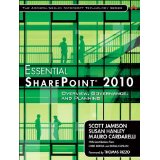Essential SharePoint 2010: Overview, Governance and Planning (Book Review)
 I had lunch with Sue Hanley at Best Practices Conference last week. She’s one of my favorite people to talk with in the SharePoint Community because of her complete focus on value to the business, outside of any technology piece. When I got home yesterday, I was surprised and pleased to find her new book, co-authored with Scott Jamison and Mauro Cardarelli, waiting on the stoop.
I had lunch with Sue Hanley at Best Practices Conference last week. She’s one of my favorite people to talk with in the SharePoint Community because of her complete focus on value to the business, outside of any technology piece. When I got home yesterday, I was surprised and pleased to find her new book, co-authored with Scott Jamison and Mauro Cardarelli, waiting on the stoop.
“Essential SharePoint 2010: Overview, Governance and Planning” is a much needed conversation from the business perspective of how to talk about governance and planning when speaking about SharePoint in your company. Tom Rizzo has an interesting comment in the forward. He talks about the perception people had when Tahoe, the first version of SharePoint, was on the drawing boards at Microsoft:
“Many folks, including myself, were nervous about how customers and partners would accept the new technology, especially given that it provided portal, enterprise search, and document management functionality.” — Tom Rizzo
The bold part is above is mine. Isn’t that the 30 second elevator pitch we’ve been looking for? One of the big problems of talking with business people is having a short handle to build from. This type of comment is typical of how Scott, Sue and Mauro have approached the content of their book.
The key to a successful SharePoint implementation is the upfront planning. Any IT department can standup SharePoint, or any company can pay for a hosted solution and get started tomorrow. The difference between success and failure is in the planning and governance phase. I like the way Sue says it: “Don’t come to me with your requirements. It’s my job to define the requirements. Your job is to tell me what the business problem is and what a final solution to that problem should look like.”
The first section of the book, Planning, is 290 pages. That’s how important the authors think the planning phase is before even popping open the box. Governance, information architecture, enterprise content management, security, planning for training and communications… these each receive their own drill down, helping you to define what is going to be needed to help you run your SharePoint implementation.
The rest of the book handles optimization issues and migration planning. From an End User perspective, this is interesting reading, but the money shot for me is the first part of the book, the planning phase.
This is a book you should seriously consider if you are responsible for SharePoint at your company. There are not enough people talking about real world business issues outside of the technology itself. Scott, Sue and Mauro have put together an essential resource you should have on your bookshelf.
Five stars, highest rating.








Does this book look at how SMB’s should approach SharePoint or is it all about Enterprise?
There was a post on LinkedIn a while back from one of the folks at Pearson offering free copies of this book in exchange for reviews on Amazon. I’m all about books (you should see both my personal as well as my SharePoint bookshelves) so I jumped on it.
I started reading through it on the way back from BPC and agree with Mark that the planning section of the book is loaded with great information and makes it worth the purchase. I am really looking forward to working through the rest of it over the next couple of weeks.
- Jay
Thanks for the review. Glad people are getting value from the book.